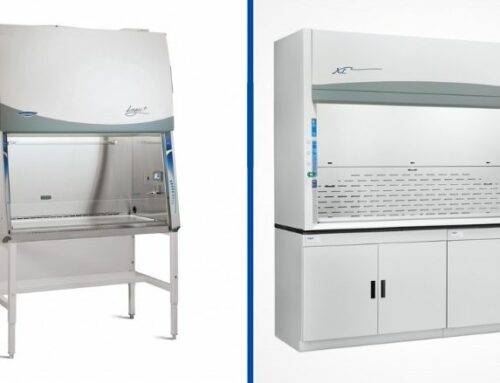Fume Hood Blowers
Suppose your business handles dangerous fumes and chemicals in a laboratory setting. In that case, the right fume hood blower is an essential piece of equipment.
This is what pushes contaminated air through the fume hood and ducting outside. If you choose the wrong motor with too little horsepower, you may put employees at risk as it won’t pull enough air from the room.
In this article, we’ll cover all the essential requirements for fume hoods with blowers and exhaust fans.
Let’s dive in!
How to Meet Lab’s Fume Hood Exhaust Fan Requirements
Depending on your lab, you may need different specifications for your fume hood blower and exhaust fans. Let’s take a look at how to meet the requirements of your lab.

What Type of Fume Hood Fan or Blower Do You Need?
Which type of blower you need depends on the intended use. If you are venting non-toxic materials, for example, you could use a steel blower coated with epoxy.
If the purpose is to mix acids, you will need an acid-resistant blower. PVC is often the best material choice for perchloric acids and other corrosive operations.
Where the chemicals in your lab are moderately or highly corrosive, fiberglass is also a good option. If your work is volatile, there are even blowers with explosion-proofing and those that are resistant to sparks.
These fume hood blowers will often come with an enclosed motor that ensures fumes in the air stream won’t encounter a spark or touch the motor.
If there’s any chance of fumes in your lab catching on fire, spark resistance should prioritize.
Tip: Unsure what type of blower you need? Match the blower to the material of the fume hood liner for a good estimation.
How to Choose the Right Size for Your Fume Hood Blower
Next, you’ll need to decide what size you’ll need for your operations. This refers to the power of the fume hood blower and is essential to ensuring your equipment transfers enough air to keep your lab free of contamination.
It’s worth noting that choosing the most robust blower is not immediately the best option. If a blower is too powerful, it could strain the ductwork and create turbulence.
Calculating the required power isn’t easy. You’ll need to consider the static pressure present in your duct system. This is calculated based on the diameter, duct length, number of bends, and velocity at which the fume will operate.
Talk to your manufacturer or reach out to CFI and consult a fume hood expert for the right choice.
How Many Operating Speeds Does Your Blower Need?
Exhausting tempered air from your fume hood is often one of the most costly energy uses for laboratories.
That’s why depending on your operations, you might benefit from a blower with multiple speed settings that will allow you to alleviate the burden of these costs.
Intelli-sense multi-speed blowers can operate at up to three speeds which are programmed through a control box. This is located on top of the hood.
A blower with this function is very versatile. It could operate at lower speeds during the night, using the least amount of air. More extensive labs that operate on a constant volume can instead use belt-driven single-speed blowers.
The Right Material for Your Exhaust System
To ensure a safe exhaust system, you need to consider the correct material for your ductwork.
Your ducting should be compatible with local fire codes. Most importantly, make sure it’s compatible with the chemicals it will be exposed to in your lab. Most commonly, duct systems will be fashioned from:
- PVC: This is intended for use with corrosives.
- 316 Stainless Steel: Suitable for use with solvents.
If you handle both corrosives and solvents, always ensure your duct system can handle the more aggressive chemical.

Where to Mount Your Fume Hood Blower
Finally, you need to decide where you’ll be mounting the blower to ensure a safe work environment for everyone.
Most blowers are mounted on the rooftop, where the exhaust stack can be oriented up to move harmful fumes into higher trade winds. This ensures contaminated air travels far from the local environment.
Suppose you are exhausting corrosive or harmful vapors. In that case, it’s vital to ensure the air won’t be exhausted into airstreams used by others on site.
Don’t let vapors flow over parking lots or exhaust them to the side of a building where they might be drawn in by air conditioning.
Best Practices for Setting up Your Fume Hood Blower and Exhaust Fan
Before we wrap up, here are some tips to keep in mind to ensure a fume hood operates efficiently.
- Keep chemicals or lab equipment away from the fume hood. It should not be used for storage, but if you have to place something inside, put it on top of blocks to allow airflow below.
- Permanently remove obstructions from the hood slots and baffles. This ensures a good airflow stays in place.
- Follow manufacturer’s guidelines for replacing your fume hood blower and other equipment. This will also indicate how much distance to maintain between the hood and your work.
- Design your laboratory in such a way that fume hoods are kept away from outside airflow influences. It shouldn’t be placed near a door or open window.
If you follow these tips, you shouldn’t go too far wrong!
Still, Have Questions About The Right Fume Hood Blower and Exhaust Fan Requirements?
We hope this guide has nudged you in the right direction to finding equipment suitable for your lab.
Remember, picking the right material and strength for your fume hood blower is crucial to ensuring it keeps you and your employees safe in the lab.
If you still have questions or need help from an expert to determine the right laboratory furniture and equipment for your needs, get in touch with us today.






